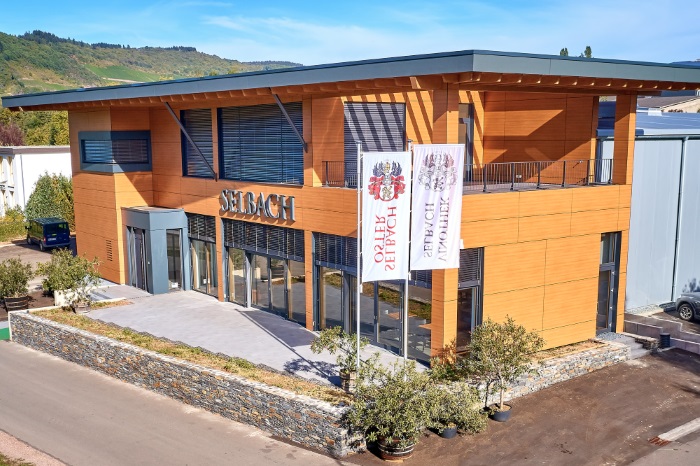Weingut Selbach Oster
06 February 2019
At the end of a bend of the charming Mosel river, just after the famous Ürzig (Ürziger Würzgarten), lies the town of Zeltingen, a sweet spot – and a short bike ride from the turist town Bernkastel-Kues. Zeltingen is a typical, idyllic river-side Mosel town, with naked stone houses, green grass planes, flower boxes in the window and streets and all of that, and here lives one of Mosel’s old-fashioned top producers: Weingut Selbach Oster.
The family is known for having made Rieslings since Early Modern Times, 1661 to be exact. They value wine growing which is in touch with nature, bringing out the elegant Mosel terroir in all their wines. Therefore, they still prefer manual labour and, all in all, stray from radical changes in their production methods and their wines. Their philosophy has been and still is ‘less is more’ and in that way they are old-fashioned yet far in front of many modern, organic, terroir-driven producers, who have not the experience of the Zeltingen family.
The now-reigning heir, Johannes Selbach, and wife Barbara do, more or less, what the parents did before, and the parents did what their grand parents did. Ask them about their dry wines, “if they are a new invention for the craving of the modern market” and they will say “no – they have been making dry wines for as long as they can remember”, and their grandparentsg would co-respond. They may be making more now, but the sweeter wines are still at the heart. And so are the dry ones – it is not an issue.
Oak in Rieslings, or Riesling in oak depending on how you see it, is something that can bring the blood to boiling at many Riesling producers. But here, too, the family shows their age-old wisdom; a little can be good (which in reality means large casks) – it allows the wine to release the fermentation gasses. Even new barrels can be used, if skillfully done – but only if kept firmly in check. Moderation is the word – and the most important work is still done in the vineyards, not the cellar.
Speaking of vineyards. The family’s most important sites are the Zeltinger Himmelreich, Zeltinger Schlossberg, Zeltinger Sonnenuhr, Wehlener Sonneuhr, and finally Graacher Domprobst, and are all quite closely situated to Zeltingen. But make no mistake, the wines from the different vineyards are quite distinct, all in their different ways. Common for these sights is that the soil is very old, 450-500 million years, and rich in minerals, yet soft so that the old roots have grown very deep and the sense of place truly shines.
Yet one large, new endeavor has found its way to the Selbach vineyards. The family has recently begun making Pinot Noir, or Spätburgunder, from old vines they have leased and bought. And we cannot wait to taste what this endeavor will bring.
We met them at last year’s ProWein, where we had a small taste of the essence of Mosel, and cannot wait to taste what this year will bring.
Here is how we scored their wines:
| Selbach-Oster Wehlener Sonnenuhr Riesling Auslese 2017 | |
| 92 | Fassprobe. Aroma had subtle botritys, honey, white peach, sweet pear, tangerine, minerals and apricot. Flavor showed apricots, lime, candied lemons, melon, honey, cantaloupe, honey melon and light noble rot. Medium acidity and sweet. |
| Selbach-Oster Zeltinger Sonnenuhr Riesling Spätlese 2017 | |
| 91 | Fassprobe. Aroma had white peach, apricots, pear, sweet apples, mange and melons. Flavor came out stronger with notes pale stone fruits, melons, lime, white blossoms, apricots, floral honey and minerals. Medium acidity and off dry, |
| Selbach-Oster Zeltinger Schlossberg Riesling Kabinett 2017 | |
| 90 | Fassprobe. Aroma had lemons, apples, white flowers lime and white peach. Flavor showed white peach, pear, apricots, apples floral honey and candied lemons. Medium acidity and off dry. |
| Selbach-Oster Zeltinger Himmelreich Riesling Halbtrocken 2017 | |
| 91 | Fassprobe - still cloudy. Aroma had sweet peach, pear, apricots, yeast, subtle tangerine and hints of apricots. Flavor showed yeast, lime, peach, apricot, melon, floral honey and exotic yellow fruits. Medium acidity and dry. |
| Selbach-Oster OMG Riesling Trocken 2015 | |
| 87 | Aroma had sweet overripe peach, apricot, honey, oranges and brettonomyces. Flavor showed oak, overripe peach, lychee, apricots, leather and brett. Medium acdidity and dry. |
| Selbach-Oster Sonnenuhr Riesling 2016 | |
| 89 | Aroma had white peach, pear, minerals, white flowers, lemons and floral honey. Flavor showed minerals, white flowers, peach, pear, apricots, lemon and floral honey. Good minerality. Medium plus acidity and dry. |
| Selbach-Oster Bömer 2016 | |
| 89 | Aroma was floral with hints of peach, pear, honey blossoms, honey and apricots. Over the palate came spices, honey blossoms, white peach, pear and apples. Medium plus acidity and dry. |
| Selbach-Oster Zeltinger Riesling Kabinett Trocken 2017 | |
| 89 | Aroma had plenty of peach, apricots and tangerine. Over the palate came white blossoms peach, fragrant apples, apricots and melon. Medium acidity and dry. Lovely ortswein Kabinett. |
| Selbach-Oster Weissburgunder Trocken 2017 | |
| 88 | Aroma had peach, pear fragrant, apples, lychee, melon and lemons. Flavor showed peach, minerals, citrus, white peach, lime, honey melon and lychee. Medium acidity and dry. Super entry level Weissburgunder. |












